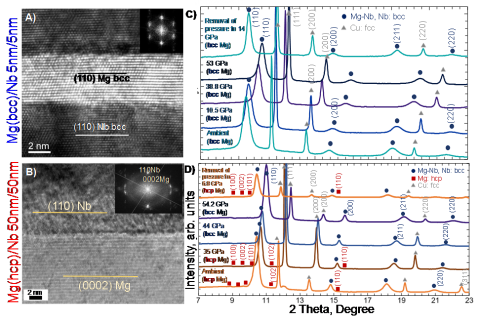Work on pseudomorphic bcc Mg chosen as an Editor’s Pick in Journal of Applied Physics
HPCAT facilities, located at the Advanced Photon Source, were used in a recent research work in order to study a unique material system – pseudomorphic body center cubic (bcc) magnesium. The team, led by Mr. Manish Jain, a Ph.D. student from the University of Nevada, Reno, utilized bi-phase interface strain engineering to transform Mg from its traditional hexagonal close packed (hcp) structure into a meta-stable cubic bcc structure at ambient temperatures and pressures.
Using PDV technique when Mg is synthesized as part of a multilayered composite with a second metal, such as niobium (Nb), it is possible to stabilize the pseudomorphic bcc structure Mg. In bcc structural form Mg has been shown to be more ductile and formable, compared to hcp Mg, since the plasticity of most metals with a bcc crystal structure is carried by 48 available slip systems with similar activation stresses.
In the work published in the Journal of Applied Physics, the team utilized synchrotron x-ray diffraction (XRD) and DAC to determine the structure and properties of the nano-laminated pseudomorphic bcc Mg phase under a broad range of pressures. The hcp Mg present in the larger layer thicknesses exhibits an hcp-to-bcc phase transformation at pressures greater than 44 GPa, and this pressure value is found to vary between the equal and unequal Mg/Nb nanocomposite thickness ratios. On the other hand, the pseudomorphic bcc Mg structure was found to be stable up to pressures of 60 GPa. Additionally, the compressibility of the pseudomorphic bcc Mg structure under pressure is shown to be fundamentally different from the bulk (non-laminated) bcc Mg structure formed under high pressures. These interesting properties are attributed to the interface-strain-induced transformation of Mg from hcp to bcc in the multilayered nanocomposite, where Mg not only assumes the crystal structure of the adjoining substrate (Nb), but also adopts the lattice parameter of Nb. These results indicate that interface strain engineering, and an appropriate choice of the adjacent layer material, might be a viable pathway for tuning the structure and properties of the pseudomorphic bcc Mg structure.
The manuscript, authored by Manish Jain, Nenad Velisavljevic, J. Kevin Baldwin, Marko Knezevic, Nathan A. Mara, Irene J. Beyerlein, and Siddhartha Pathak, titled ‘Structure and Properties of Pseudomorphically Transformed bcc Mg in Mg/Nb Multilayered Nanolaminates studied using Synchrotron X-Ray Diffraction’ Journal of Applied Physics (doi: 10.1063/1.5097249), was chosen and is being promoted as an Editor's Pick by the journal editors.
Figure. HR-TEM Images of A) bcc/bcc Mg/Nb 5nm/5nm, B) hcp/bcc Mg/Nb 50nm/5nm, and comparison of synchrotron XRD curves obtained at various pressures for (C) bcc/bcc Mg/Nb 5nm/5nm, D) bcc/hcp Mg/Nb 50nm/50nm using HPCAT facilities at the Advanced Photon Source.

